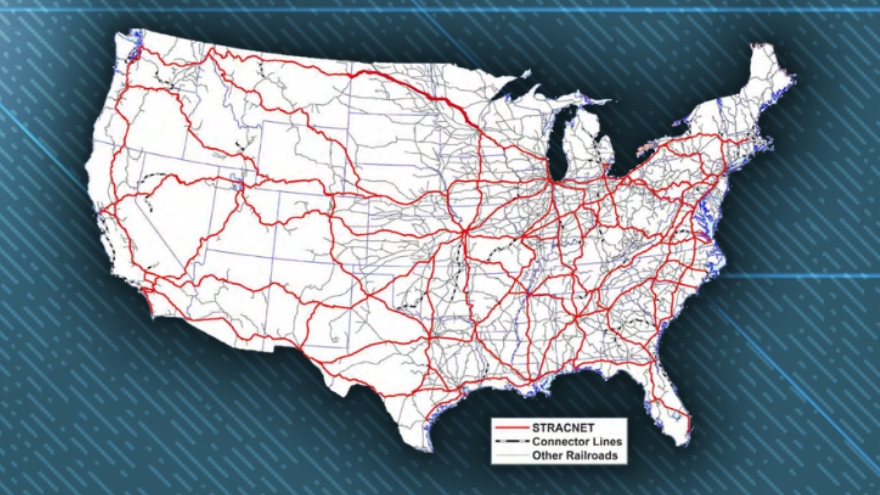The United States has recently experienced numerous high-profile incidents involving the destruction of critical infrastructure, including fires at warehouses and food processing plants, and other events impacting the nation’s food, water and energy assets.
A primary concern for many are train derailments across the U.S., some of which have resulted in ecological damage to surrounding areas, killing animals and contaminating the water supply. Such events are garnering closer national scrutiny.
The sharp focus placed on these incidents by media and online personalities has sparked concern that the destruction may be part of an asymmetric warfare campaign undertaken by one or more U.S. adversaries. Often named as a suspect is Russia, whose officials have vowed “consequences” after an explosive report was published by award-winning investigative journalist Seymour “Sy” Hersh, alleging that U.S. President Joe Biden ordered the destruction of Russia’s Nord Stream 2 natural gas pipeline to Europe.
Though there have been more than a dozen train derailments this year, these incidents have been on the decline. In 2021, there were 1,087 train derailments, which averages to about three per day. Other data from the Bureau of Transportation Statistics show an average of 1,704 per year (4.73 per day). This means the U.S. is currently behind pace for train derailments.
But, against the backdrop of the specter of war with Russia and/or China, questions mount concerning the possibility that foreign or domestic actors may be acting as saboteurs. Timcast was urged by a military professional to examine connections between train accidents and military lines of transportation or facilities.
One common denominator among the spate of recent train derailments is that many have occurred along a key railway system used by the military — the U.S. Department of Defense’s Strategic Rail Corridor Network, otherwise known as STRACNET.
The U.S. Department of Transportation supports the STRACNET program, which enables the DoD to “access more than 32,000 miles of rail lines to move essential military equipment to ports located around the country and to connect military facilities,” according to a report from the Defense Technical Information Center.
STRACNET is one of three programs within the DOT that enables U.S. military forces to “surge capability when needed anywhere in the world,” the report states, and to quickly mobilize to defend the nation during an emergency. Structural disruptions to this railway network could impede the military’s ability to move equipment should a serious event arise.
A 1976 letter from the Army to the DOT’s Federal Railroad Administration highlights seven states where more than 50 percent of DOD carload traffic originates — California, Michigan, Pennsylvania, North Carolina, South Carolina, Tennessee, and Texas. Within the past two months, each of those states has had derailment incidents.
“It is essential that quality rail lines be maintained in the corridors to ensure that rail movement is available to meet national defense requirements,” Maj. Gen. H.R. Del Mar wrote in the letter. The DoD is heavily dependent upon rail service for movement of large quantities of cargo and oversize or overweight equipment, like ammunition, explosives, M88 Recovery Vehicles, and heavy track vehicles. This equipment is transported throughout the U.S. to domestic bases for training, as well as for overseas deployments.
Given the significance of the railway system, some feel that recent train accidents may be targeted actions facilitated by U.S. adversaries.
“We literally have a dozen toxic national environmental disasters, whether it’s trains, whether it’s a fixed toxic chemical storage facility or manufacturing plant randomly catching fire, that does not happen,” a former military specialist, who spoke on the condition of anonymity because they still work as a contractor, told Timcast.
“Oh, it’s just accidental?” they asked before linking the incidents to escalating tensions with Russia and China.
The source noted the ease with which a derailment can be carried out: “Okay, so this is a train. That’s ‘Demolitions 101,’” they stated, before following with six separate examples of how to derail a train. “Any child, any middle schooler with enough time, and you don’t even need that much time, can sabotage any railway.”
They added that if there were evidence implicating rogue foreign actors in the recent damage to U.S. infrastructure, the federal government would likely maintain a cloak of secrecy.
“If the government comes out and says that, that’s World War III,” they said.
“The mathematical improbability of coincidence that all these dozen things are going wrong right at this very second,” the source continued. “And all these train derailments, you know, it doesn’t take a butcher to smell bullshit.”
However, senior officials within the federal government dispute the idea that spies or other foreign actors are behind the recent train derailments.
Dan Zedack, Chief of the U.S. Army’s Military Surface Deployment and Distribution Command (SDDC) Railroads for National Defense (RND) Program, says that he is unaware of any information showing U.S. train derailments connected to a sabotage operation.
“We haven’t seen anything about international access sabotage,” Zedack told Timcast in an interview.
“There are no incidents or trends that are alarming to us. You know, the rail network is a pretty vast network, and there are, as you alluded to, a lot of groups that have different interests therein,” he explained. “And we do get reporting on some of these things that come across. But, again, there’s no DoD concern at this time for anything like that.”
Zedack says that a widespread outage of the rail network would “degrade our ability to deploy.” However, the acute disruptions cause by sporadic train derailments have not impeded the military’s ability to function at a high level.
“The network is resilient enough both in alternate routes available and in the repair capabilities of the railroads to get the track open relatively quickly,” he says. Even in the case of the devastating Feb. 3 derailment in East Palestine, Ohio that resulted in toxic chemicals being spilled and burned into the atmosphere, both mainline tracks were re-opened by Feb. 7, he explained.
Overall railway security is robust with the Federal Railway Administration, state railway agencies, and commercial railroad companies working with the DoD, Transportation Security Administration and U.S. Department of Homeland Security to shore up defenses and mitigate threats.
Zedack dispelled rumors that the federal government is hiding information about the train derailments, reiterating, “We’re certainly not withholding anything.”
He added that the DoD is very dependent on STRACNET both in peacetime and in warfare, but says the military has a good working relationship with all the rail carriers and regulators, which allows military assets to easily and quickly be re-routed to private rail networks with no problems.
A separate former military specialist agrees that foreign sabotage is likely not to blame for the recent train derailments and destruction of U.S. infrastructure.
“I don’t see this, we’re not currently at war,” a former Navy SEAL speaking anonymously told Timcast in an interview. “So what would be either the message or strategic advantage for targeting that particular network and a relative time of peace?”
He added, “It sounds like it would be incredibly unlikely. I mean, there’s a ton of moving pieces and opportunity to get caught.”
The source, who served more than 20 years combined in Special Operations Forces and as a military and counter-terrorism contractor, emphasized that a key data point to consider would be whether there are more incidents now than in year’s past, which, as documented earlier, is not supported empirically. He also suggested environmental extremism could potentially play a role in the disasters and derailments.
“Frankly, the number one cause for terrorists in the United States are environmental terrorists, the ones that do the most,” he explained. “And you can go into the FBI database — and I’m sure they’ve tried to hide that now or obscure it — but, I was a contractor for the FBI for a number of years, and that was the number one organization that did the most property damage in the United States.”
He says, “everybody’s kind of in conspiracy mode right now,” due to so much media coverage of train derailments and infrastructure fires.
“These stories have taken on a life of their own,” he cautioned. “So, it’s good to have a more level-headed conversation with you and, giving sort of the other side to this that, hey, maybe there’s nothing there.”
Multiple DOT officials were contacted by Timcast for comment. Most declined to speak. However, one Transportation Department official agreed to speak on the condition of anonymity, as they are currently employed by the government and are not authorized to speak to the press.
The source says they have not seen any information suggesting terrorism, or sabotage by a major crime syndicate or foreign interests hostile to the U.S.
They did, however, cite a string of incidents that have taken place in California during the past few years involving derailments committed by individuals who wanted to steal cargo.
“It’s folks trying to commit theft to trains. And so they’ll try to stop a train or derail a train to commit theft out of a box car or something like that,” the official told Timcast.
A number of California’s railway theft incidents have been concentrated in Los Angeles County, impacting a single railroad company: Union Pacific. The incidents began during late 2020, leaving some speculating that the motivation behind the heists was the nation’s economic implosion and supply chain disruptions caused by the pandemic response.
However, the unnamed source says those derailments are likely linked to the termination of Union Pacific employees, including its railroad police, who were laid off after the company sought to “streamline operations” in 2020.
In 2018, the company had more than 44,500 employees. Data from the federal Surface Transportation Board shows Union Pacific lost more than 4,600 workers between the end of 2019 and the end of 2021. The company’s most updated security policy says the railroad is “budgeted for 126 sworn police officers (commonly referred to as special agents).”
“Now Union Pacific did lay off 90 percent of their special agents from what I understand. Each railroad has their own police department and police force. So the Union Pacific laid off most of theirs,” the official stated. “And when that happened, the incidents went up because there’s no one out there trying to monitor or respond to that stuff.”
Sabotage was being committed in rail yards that would cause a train to derail, forcing it to stop, so that a team of four-to-five looters could break into it and steal its contents, they said.
The official added it was “more of a low level organized crime ring, like a neighborhood ring that’s targeting the intermodal trains,” they explained. “And that’s where all your consumer goods are usually transported.”
According to a letter sent from Union Pacific to the Los Angeles County District Attorney, between Dec. 2020 and Dec. 2021 the railroad experienced a 160 percent increase in criminal rail theft in LA County, resulting in roughly $5 million in claims, losses, and damages.
“In several months during that period, the increase from the previous year surpassed 200 percent. In October 2021 alone, the increase was 356 percent over compared to October 2020,” wrote Adrian Guerrero, UP General Director for Public Affairs. “Not only do these dramatic increases represent retail product thefts – they include increased assaults and armed robberies of UP employees performing their duties moving trains.”
In general, train derailments are a common occurrence. So too are fires at warehouses and food processing plants across the country. Available data confirms that there has not been an upsurge in these events, despite the fact they are getting more attention in the news and on social media platforms. And officials within the military and transportation sectors confirm, insofar as they know, that these events are not part of a nebulous asymmetrical warfare campaign.

